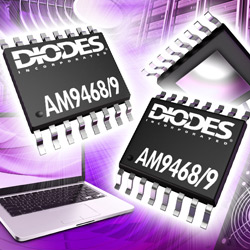Diodes Incorporated's new AM9468 and AM9469 brushless DC motor drivers use a bridge-tied load (BTL) drive architecture to minimize switching noise and electromagnetic interference (EMI). The cooling fan provides intelligent drive. Similar devices and support a variety of other medium voltage, low power, motor driven applications.
Flexible motor speed control can be achieved using external PWM signals or DC voltages, or voltages obtained from a thermistor network. The AM9468 / AM9469 then adjusts the duty cycle of the full-bridge output driver stage based on this input signal, while a separate frequency generator provides tachometer output to monitor the motor speed from the outside. The BTL architecture amplifies the sinusoidal magnetic flux density signal used to drive the motor coils. This avoids large changes in current during commutation and helps achieve low noise operation. The speed control PWM duty cycle is superimposed on the BTL drive signal.
AM9468 / AM9469 have built-in fast-start circuit and rotor lock detection function. This prevents the motor coils from overheating or burning, and also ensures automatic restart after removing the lock. Other features include a current-limiting circuit and a Hall-biased output, all of which contribute to the solution, which significantly reduces the number of external components and PCB footprint, and reduces component and manufacturing costs .
The AM9468 is available in a standard, power-capable TSSOP-16 package, while the AM9469 is available in a thermally enhanced exposed pad TSSOP-16EP package that can provide or sink up to 700mA of output current. Thermal shutdown circuits provide overheating protection, which is especially valuable for protecting the closed coils and PCBs of cooling fans in consumer applications with heat demand. Both devices have an operating temperature range of -40C to 105C.
